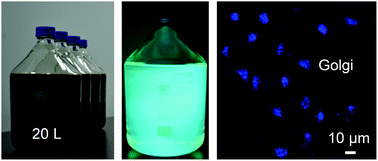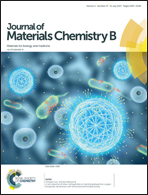Industrial production of ultra-stable sulfonated graphene quantum dots for Golgi apparatus imaging†
Abstract
The wide use of functionalized graphene quantum dots (GQDs) in stable dispersions is currently hampered by the lack of industrially scalable, low-cost, and eco-friendly methods. Herein we report the first realization of the industrial-scale (20 L) production of high-quality fluorescent GQDs via a molecular fusion route from a low-cost, active derivative of pyrene. By a wholly “green”, conventional sulfonation reaction at low hydrothermal temperature, the molecular precursor is wholly converted into highly water-soluble, sulfonated GQDs without byproducts such as insoluble carbon. The GQDs show superior optical properties including strong excitonic absorption bands extended to ∼530 nm, bright photoluminescence (PL) at 510 nm with a quantum yield of up to 42%, and a wide PLE spectrum. The edge-site sulfonic functionalization enables the GQDs to stably re-disperse in water and maintains high fluorescence activities even after annealing up to 250 °C, whereas amino GQDs and graphene oxide sheets markedly aggregate after drying at low temperature. The GQDs are applied as biological fluorescent probes for visualizing and targeting Golgi apparatus in Hela and MCF7 live cells. The low-cost mass production, excellent biocompatibility, and superior optical properties make the GQDs an attractive alternative probe for efficient Golgi targeted imaging in biomedical applications.



 Please wait while we load your content...
Please wait while we load your content...